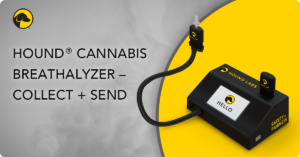
Specimen Custody and Control – A Critical Component in Workplace Testing
Fans of law enforcement and legal television shows like Chicago PD and Law & Order have probably heard the term ‘chain of custody’ when referring to evidence collection and tracking. Chain of custody is a rigorous yet extremely important process in evidence collection and critical to the success of a criminal court case. If an attorney can prove the chain of custody was not followed, they can request that the evidence be declared inadmissible.
Demonstrating the chain of custody of a drug testing specimen is just as critical to supporting the defensibility of a workplace drug test in court. The chain of custody in workplace drug testing provides protection for both the donor and the employer, ensuring that the collection, transportation, and testing of a specimen were administered correctly.
DRUG TESTING CHAIN OF CUSTODY
Chain of custody in drug testing is most often thought of as a form of paperwork, but it is broader than just a form – it is a critical process that is recorded using a form. Chain of custody refers to the paper trail documenting the collection, testing, and analysis of a human specimen and is commonly used in both workplace and criminal justice. It is the chronological documentation of the sequence of custody, the transfer, control, analysis, and disposal of any physical or electronic evidence of a drug test.
The responsibility for completing the chain of custody falls on the person collecting the specimen and is never the responsibility of the manufacturer of the test. Therefore, it’s critically important for anyone conducting drug testing to make sure the collector is fully trained and aware of the consequences of breaking the chain of custody or for not following the specific directives on the form.
DOCUMENTATION PROCEDURE
The chain of custody of any particular specimen is documented on a Chain of Custody Form (COC) or, in federal programs, a Federal Custody and Control Form (CCF). Since 2015, Federal CCFs were modified to allow for electronic forms following the process that had become commonplace for non-DOT programs since the early 2000s.
The Federal CCF is very prescribed, and the information and the form leave little room for variation. However, a non-DOT chain of custody varies by laboratory and may be customized to contain or eliminate information that may be required by an employer to collect a specific specimen. Before discussing how forms and processes can be modified, it is essential to understand the standard information contained as part of the chain of custody process and the purpose of those elements.
WHAT DOES CHAIN OF CUSTODY INCLUDE?
The chain of custody first includes recording demographic information that provides information establishing the requisitioning agent and the reporting. In workplace drug testing, the requisitioning agent is the employer for whom the test is ordered. The other information is the collector performing the drug test collection, the Third Party Administrator (TPA) if one is used, and the Medical Review Officer (again, if used). Finally, as the collection of a specimen begins for a donor, the information on that donor is recorded, including names, phone numbers, and employee identification or social security number.
The chain of custody is also used to record any refusal to test, adulteration attempt, or inability of a donor to produce a specimen.
Each chain of custody includes a specimen identification number, tamper-evident specimen labels, and a numbered barcode to match the form. The collector must be trained on what steps are recorded, read a certification statement attesting to the collection process, and both the donor and the collector must sign attesting the information is true and correct. The donor-initialed specimen labels are added to the specimen tying the form and the specimen together. This critical step ensures the integrity of the test.
Once the specimen is collected, the signatures are attained, and the labels are affixed to the specimen, it is packaged and sent to the laboratory. If a laboratory result is challenged, the chain of custody can prove the secure identification of the specimen, and the tamper-evident labels prove the sample remained intact until it was opened at the laboratory for testing.
POINT OF COLLECTION TESTING PROCEDURE
In point of collection (POC) testing, a chain of custody is sometimes neglected; however, it serves an important role. The Chain of Custody forms are often combined to include both the details required to track the details of the collection, and the record of the results. When a POC result is negative, the specimen is discarded, and the Chain of Custody form serves as a record of the drug test. In the case of a positive POC test, the specimen and the Chain of Custody form can simply be packaged together and sent to the laboratory for confirmatory testing.
When developing the HOUND® CANNABIS BREATHALYZER, the team worked to ensure that completing a Chain of Custody form would be easy to do while also administering a breath test. The handheld uses a single-use cartridge that automatically collects the correct amount of breath required for testing on the base station, confirmation at the laboratory, and a third sample stored at the lab for additional testing if required. The ultra-sensitive base station tests the specimen with the touch of a button and produces a result that is recorded on the base station and transmitted to Hound Labs Retriever™ database. This step removes the guesswork of interpreting results by a collector and ties the specimen result to the donor. Finally, the innovative design of the cartridge is tamper-evident, adding a layer of protection to ensure specimen integrity.
Again, completing the chain of custody is the responsibility of the person collecting the specimen and is never the responsibility of the manufacturer of the testing. Anyone conducting drug testing must make sure the collector is fully trained and aware of the consequences of breaking the chain of custody.
Chain of custody is a critical component to workplace drug testing and its legal defensibility if brought to court for employee screening. For more information on how to evaluate a cannabis breathalyzer, click here to read a checklist created by our CEO, Dr. Mike Lynn.

February 24, 2022
By NINA M. FRENCH
Share














